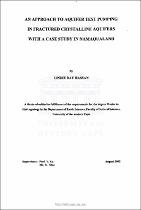| dc.description.abstract | Water resources in South Africa are being stressed. Due to this concern more emphasis should be placed on determining where we can improve our existing methods for the calculation of sustainable yield. Current approaches to calculate aquifer parameters employ general techniques that may not be appropriate to fractured crystalline aquifers. The underlying principles for the methods are based on homogeneous and isotropic aquifer systems of infinite aerial extent.
With the use of pump-testing methods aquifer parameters such as transmissivity (T) and storativity (S) are determined. These parameters are important for calculating the sustainable yield of the aquifer system. A general conceptual model is adopted for the Namaqualand area. The model is based on fractures with high transmissivity and low storativity as well as a matrix component, comprising of micro-fractures/fissures, with lower transmissivity but higher storativity. The hydraulic contrast between fracture and micro-fractured matrix for these fractured, crystalline aquifers influences the hydraulic connectivity and hydraulic gradients observed during pump-testing operations. The model is based on a double porosity system developed for the fractured sandstone aquifers of the Karoo formations. In the case study it illustrates that the model can be applied to the fractured crystalline aquifer.
The drilling of monitoring boreholes is an expensive procedure and therefore it is not always seen as compulsory. This can be one of the reasons why boreholes in semi-arid regions run dry over a short period of time. When no monitoring boreholes exist, parameters such as transmissivity (T) and storativity (S) can only be estimated using a pumping borehole. This can have a negative result on the sustainable yield calculations of the aquifer system. Another important question then is; once a monitoring borehole is drilled, is it hydraulically connected to the pumping borehole? The heterogeneity determines to a great extent the degree of hydraulic connectivity. When there is a monitoring borehole present that is not hydraulically connected one has to revert to using only the pumping borehole. A lot of error can occur in applying these methods to pumping boreholes because of the distance dependency of the storativity parameter if the usual interpretations are used. In the case study a method is outlined that addresses this specific difficulty. Once the appropriate methods are chosen and a good conceptual understanding of the specific aquifer system has been developed, aquifer parameters can
be calculated. For this specific study, the EXCEL based software program, AQUATEST,
was used to do the required transmissivity, storativity and total well loss calculations.
In this case study the issues discussed above are addressed. The hydraulic connectivity is illustrated using different scenarios and a method for solving the inaccuracy in determining the storativity (S) component is suggested, which involves the correct determination of the effective radius of a pumping borehole. The total well loss is calculated using AQUATEST, which allows the correct calculation of drawdown within the aquifer at a specific time. Boundary conditions are also applied in AQUATEST, making use of the improved Cooper Jacob method, before the final calculation of transmissivity (T) and storativity (S) parameters. | en_US |

